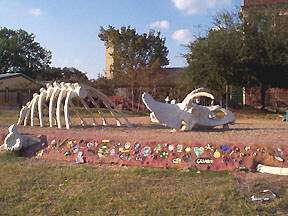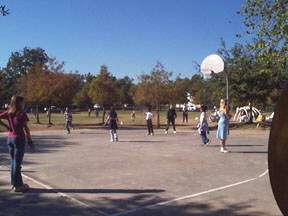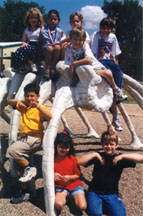|
|
The dinosaur theme
for the Travis SPARK Park was determined by the students. Each
child designed their ideal playground in their art classes. Girls
and boys alike in grades K-5 overwhelmingly chose dinosaurs. |
|
SPARK a non-profit park program, attempts to make school playgrounds accessible to the community by using federal grant money, school district funds and private donations to fix up each playground. One of the most notable is the playground at Travis Elementary School. In addition to planting many trees, installing a jogging track and putting in modular playground equipment, SPARK had artist Paul Kittelson construct what looks like a dinosaur skeleton out of concrete. The phony bones can be climbed on, crawled under, whatever. |
|
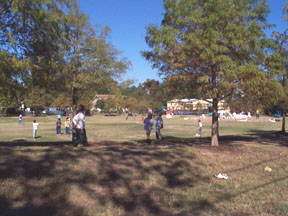 |
"Travis School, one of the best built and most modern of Houston's fine system of public schools, is located in Woodland Heights, and was erected during 1908-09. Its unusually large playgrounds, covering an entire block, were donated to the city for the purpose." -- From a 1910 brochure from the William A. Wilson Realty Company, developer of the Woodland Heights subdivision. |
|
Noted landscape architect and Travis parent Scott Slaney was instrumental in the design of the park. The park features a recessed baseball diamond with a jogging track around it. A major landscape features is some 87 bald cypress trees. In 1998 a cooperative project between HISD and the Woodland Heights Civic Association installed a beautiful, historic, loop and spear iron fencing around the entire playground. |
|
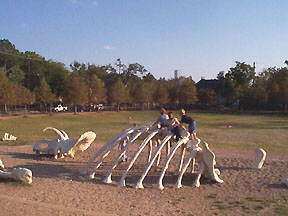 |
The saga of the dinosaur began in 1989 when the newly-formed Friends of Travis began working to develop a master plan to turn Travis, one of the older facilities in HISD, into the kind of exciting learning center that attracts and holds the most promising students. Some of the designs were very sophisticated, incorporating interactive pieces like scales that were stairs and tongues the children could slide down. Determined to honor the children's overwhelming input, the group researched all playground equipment. Discovering that the children were way ahead of the adult designer, there was nothing for sale that even approximated the vision! |
|
Paul Kittleson, a local artist whose prehistoric artwork was once featured on Montrose Boulevard under U.S. Highway 59, was commissioned for the job. Kittleson's design was so innovative that the parents had to hire a playground safety expert to convince HISD that the dinosaur could be constructed safely. Installation of the first phase of Kittleson's design, which included a huge skull and a climbable skeleton partially buried in the sand, cost $12,700. The second phase, completed in 1992 and paid for partially with funds the SPARK program, included more sand pits with bones, a terraced area with concrete steps, a toddler's play area, and wooden playground equipment. |
|

